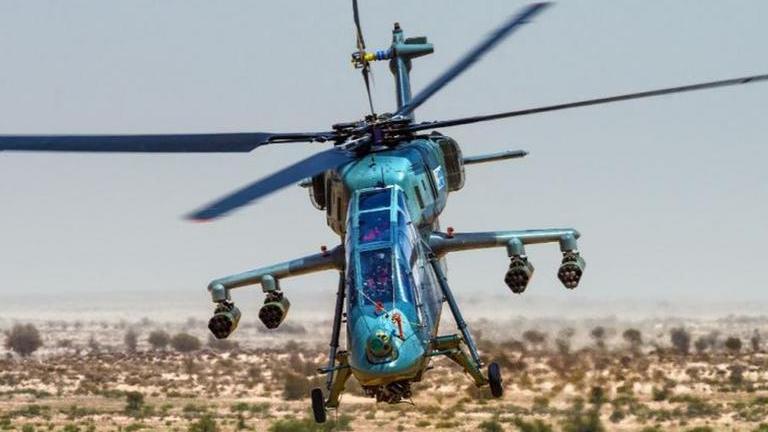145 Made-in-India Light Combat Helicopters 'Prachand' To Enter Mass Production Soon
Government sources have confirmed that the highly anticipated mass production of the 145 Light Combat Helicopter(LCH) "Prachand" will commence soon. On June 15, Air Marshal Ashutosh Dixit, Deputy Chief of the Air Staff, visited Hindustan Aeronautics Limited (HAL) and personally flew the series production trainer-01 of the LCA Tejas. During the meeting, he received a comprehensive briefing on the production status of the indigenous combat helicopter.
3 Things You Need To Know
- Air Marshal Ashutosh Dixit, Deputy Chief of the Air Staff (DCAS), visited the National Flight Test Centre, Aeronautical Development Agency, and HAL Tejas Division.
- Delivery of 10 LCH Limited Series Production aircraft for the Indian Air Force is nearing completion.
- The LCH's exceptional combat capability at high altitudes emerged as a groundbreaking advantage, revolutionising operations in the challenging Himalayan region, including Siachen.
In March 2020, the Cabinet Committee on Security (CCS) approved the acquisition of 15 limited series Production (LSP) variants of LCH at the cost of ₹3,887 crore. Out of the 15 helicopters, 10 were allocated to the IAF and five to the Army. The IAF has deployed its LSP variants of the combat helicopter in Jodhpur near the Indo-Bangladesh border, while the Army has stationed the first squadron of LCH just 250 km from the Line of Actual Control (LAC) in Missamari, Assam.
Prachand: India's First Indigenous Combat Helicopter
The twin-engine LCH, designed by HAL, is a 5-8 tonne combat helicopter specifically tailored for high-altitude operations. It boasts a combat radius of 500 km and a service ceiling of 6,000–6,500 metres. The helicopter incorporates stealth features, armour protection, and night attack capability. Equipped with a glass cockpit, low radar cross-section, and integrated systems such as the Integrated Architecture Display System (IADS), Countermeasure Dispensing System (CMDS), electro-optical (EO) pod, and electronic warfare (EW) suite, the LCH is a formidable multirole combat helicopter.
Armed with a 20mm gun, rockets, and air-to-air/air-to-ground missiles, the LCH has a maximum takeoff weight (MTOW) of 5,800 kg, a top speed of 268 km/h, a range of 550 km, and a service ceiling of 6.5 km. It is powered by two HAL/Turbomeca Shakti-1H1 engines, each providing 1,032 kW of power. The engines are fitted with infrared suppressors. The LCH's design enables it to perform various attack profiles, including high-altitude warfare. It excels in anti-infantry, anti-armour, destruction of enemy air defence (DEAD) operations, urban warfare, counter-insurgency operations, counter surface force operations (CSFO), escort to special heliborne operations (SHBO), combat search and rescue (CSAR) operations, and armed aerial scouting duties. The LCH features a narrow fuselage, stealth profiling, and advanced rotor technology inherited from the HAL Dhruv.
Enhancing fighting capabilities
The Army is strategizing to integrate attack helicopters into all pivot formations, bolstering close anti-armour support. Simultaneously, the Air Force's induction of these helicopters seeks to empower the IAF with the capacity to effectively neutralise high-altitude objectives and counter the dwindling numbers of attack helicopters within its fleet. Notably, the Indian Army has plans to acquire approximately 95 LCH units, while the IAF is slated to receive 65, further enhancing its operational capabilities.
Addressing Operational Gaps
Currently, the LCH lacks an electronic warfare suite, unlike the weapon systems-integrated version of the Advanced Light Helicopter 'Rudra,' which already incorporates Saab's Integrated Defensive Aids Suite (IDAS). IDAS equips the aircraft with radar warning receivers and missile and laser warning systems, enabling the sensors to detect threats from any position relative to the aircraft. Once a hostile target is identified, the system automatically selects an appropriate countermeasure response, deploying countermeasures to deceive incoming projectiles or radar. The initial plan was to develop an indigenous electronic warfare system for the LCH, designed by DRDO (Defense Research and Development Organization). However, the development process is still underway.
October last year, during the Navratri festival, the LCH was inducted into the Indian Air Force and was named Prachand by Rajnath Singh, India's Defence Minister. During the induction ceremony, he said, "The induction of indigenously developed Light Combat Helicopters (LCH) will enhance our capability and boost defence production. There could not have been a better timing for the LCH induction than Navratri and in the land of warriors, Rajasthan."

www.republicworld.com


